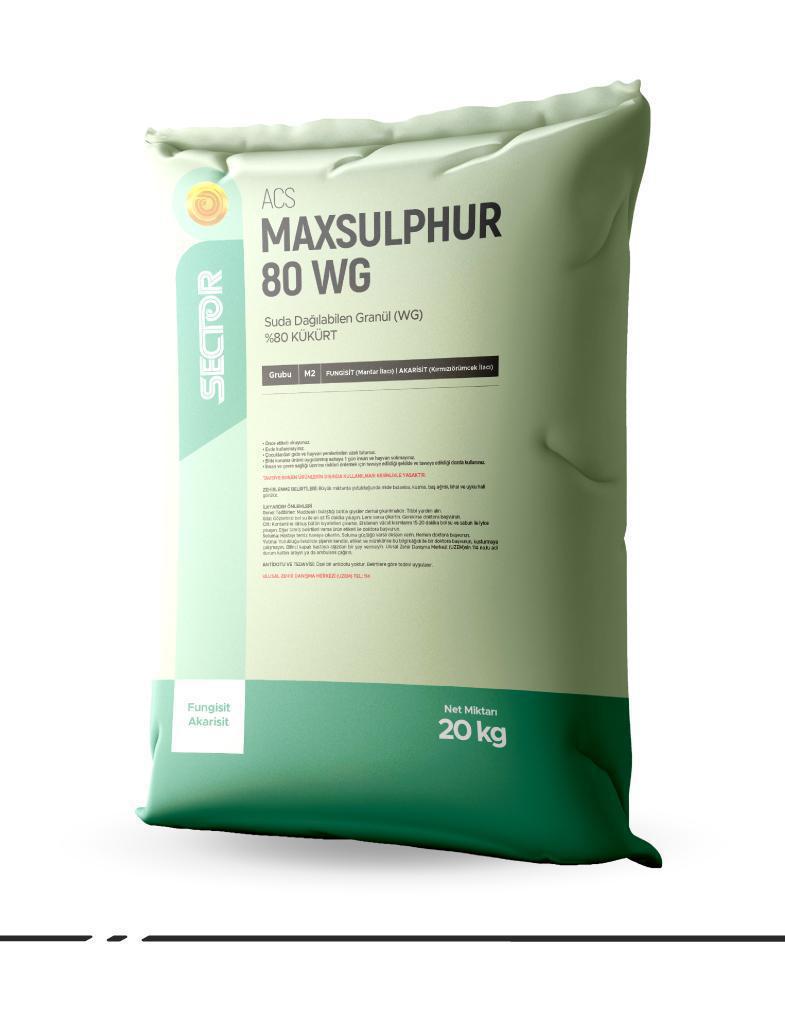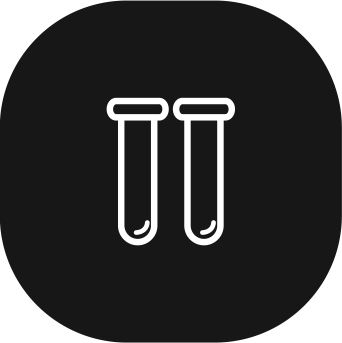
ACS Maxsulphur 80 WG
Category: Crop Protection
Product Group: Fungicide (Fungicide)/Acaricide (Red Spider Mite Acaricide)
Active Agent: 80% SULPHUR
Formulation: Water Dispersible Granule (WG)
Grapevine Powdery Mildew: 1st spraying: before flowering when the shoots are 25-30 cm 2nd spraying: during the period when flower buds separate before flowering, 3rd spraying: during the period when the petals fall off and the unripe grapes are the size of small shots. 4th and other sprayings are carried out after the third spraying depending on the effectiveness of the fungicide used until veraison. Grape-Bud Mite: Since the fungicide used to control grapevine powdery mildew also controls this harmful organism, no special spraying is required against grape-bud mite. Apple Powdery Mildew: 1st spraying: During the pink flower bud period, 2nd spraying: During the period when 60-70% of the petals fall off, 3rd and other sprayings: As long as the suitable conditions for the disease continue, the spraying continues depending on the duration of effectiveness of the fungicide used. Peach Powdery Mildew: 1st spraying: It should be determined considering the intensity of the disease in previous years. If the disease is seen for the first time in the garden, it is sprayed as soon as the symptoms are detected. If the disease has appeared in previous years and the percentage of diseased shoots on the trees reaches 1/3 in the checks to be made after pruning, the first spraying should be carried out before the symptoms appear. 2nd and Other Sprayings: In plant development, spraying continues until the disappearance of infection conditions, taking into account the duration of effectiveness of the preparation used. Rose Powdery Mildew: The first spraying should be carried out at the beginning of leaf and bud formation. Spraying should be carried out in the morning chill, in windless and rainless weather, and the entire surface of the plant should be sprayed. Depending on the duration of the effectiveness of the fungicide used and the course of the disease, spraying may be repeated. Begonia Powdery Mildew: Spraying should begin when the first signs of disease are seen on the leaves. Spraying is repeated every week. Chickpea Anthracnose: Seed spraying: It should be applied on the day of sowing. Green part spraying: Even if it is necessary to start the spraying when the daily average temperature reaches 160C and the proportional humidity reaches 80%, it should be started practically when the first signs of the disease are seen in the region. Spraying should continue depending on the severity of the disease, climatic conditions and effectiveness of the fungicide. If it rains heavily on the day of spraying, the spraying should be repeated. Onion Downy Mildew: Even if it is necessary to start the control when the daily average temperature reaches 160C and the proportional humidity reaches 80%, spraying may begin when the first signs of disease are seen around. Bean Rust: Spraying should begin as soon as rust pustules are seen on the leaves of bean plants around, and spraying should continue depending on the severity of the disease, climatic conditions and duration of effectiveness of the fungicide. If the disease occurs at maturity of capsules of dry beans, spraying is not necessary because it does not cause economic losses of product. Powdery Mildew on Cucurbitaceae: Spraying begins when the first signs of disease are seen. Spraying should continue depending on the severity of the disease, climatic conditions and duration of effectiveness of the fungicide. Spraying should be stopped when the daily average temperature is above 27oC and the relative humidity is below 50%. Citrus Red Spider Mite: Spraying should begin before the harmful organism is transferred to fresh shoots, i.e. in the period before flowering. If it is late for this period, spraying can be carried out one week after fruit set. The inside and outside of trees, the undersides and tops of leaves should be sprayed thoroughly. Spraying should not be done in the hottest hours of the day and early morning because of the dew on the leaves. Citrus Bud Mite: In gardens known to be infested with the harmful organism, spraying is carried out in late March and early April, when shoots are 8-10 cm tall, depending on climatic conditions in the spring, when the transition from old to new buds is greatest. Spraying is repeated 20-25 days after the first spraying. Powdery Mildew on Solanaceae: Spraying begins when the first symptoms are detected in the field. Depending on the climatic conditions and the course of the disease, 3-5 applications are carried out at 10-day intervals.
| PLANT NAME | HARMFUL ORGANISM NAME | APPLICATION DOSAGE |
| Vineyard* | Powdery Mildew (Erysiphe necator) | 400 g/100 L water |
| Grape-Bud Mite (Eriophyes vitis) | 490 g/100 L water | |
| Apple | Apple Powdery Mildew (Podosphaera leucotricha) | 400 g/100 L water |
| Peach | Peach Powdery Mildew (Sphaerotheca pannosa) | 400 g/100 L water |
| Rose | Rose Powdery Mildew (Sphaerotheca pannosa var. rosae) | 400 g/100 L water |
| Begonia | Begonia Powdery Mildew (Microsphaera begoniae) | 300-350 g/ 100 L water |
| Chickpea | Chickpea Anthracnose (Ascochyta rabiei) | 300 g/100 L water |
| Onion | Onion Downy Mildew (Peronospora destructor) | 300 g/100 L water |
| Bean | Bean rust (Uromyces appendiculatus) | 300 g/100 L water |
| Cucumber | Powdery Mildew on Cucurbitaceae (Erysiphe cichoracearum) | 400 g/100 L water |
| Citrus* | Citrus Red Spider Mite (Panonychus citri) | 600 g/100 L water |
| Citrus Bud Mite (Aceria sheldoni) | 600 g/100 L water | |
| Eggplant | Powdery Mildew on Solanaceae (Leveillula taurica) | 400 g/100 L water |


 Türkçe
Türkçe  English
English  Russian
Russian  Arabic
Arabic  Germany
Germany  French
French  Spanish
Spanish 








